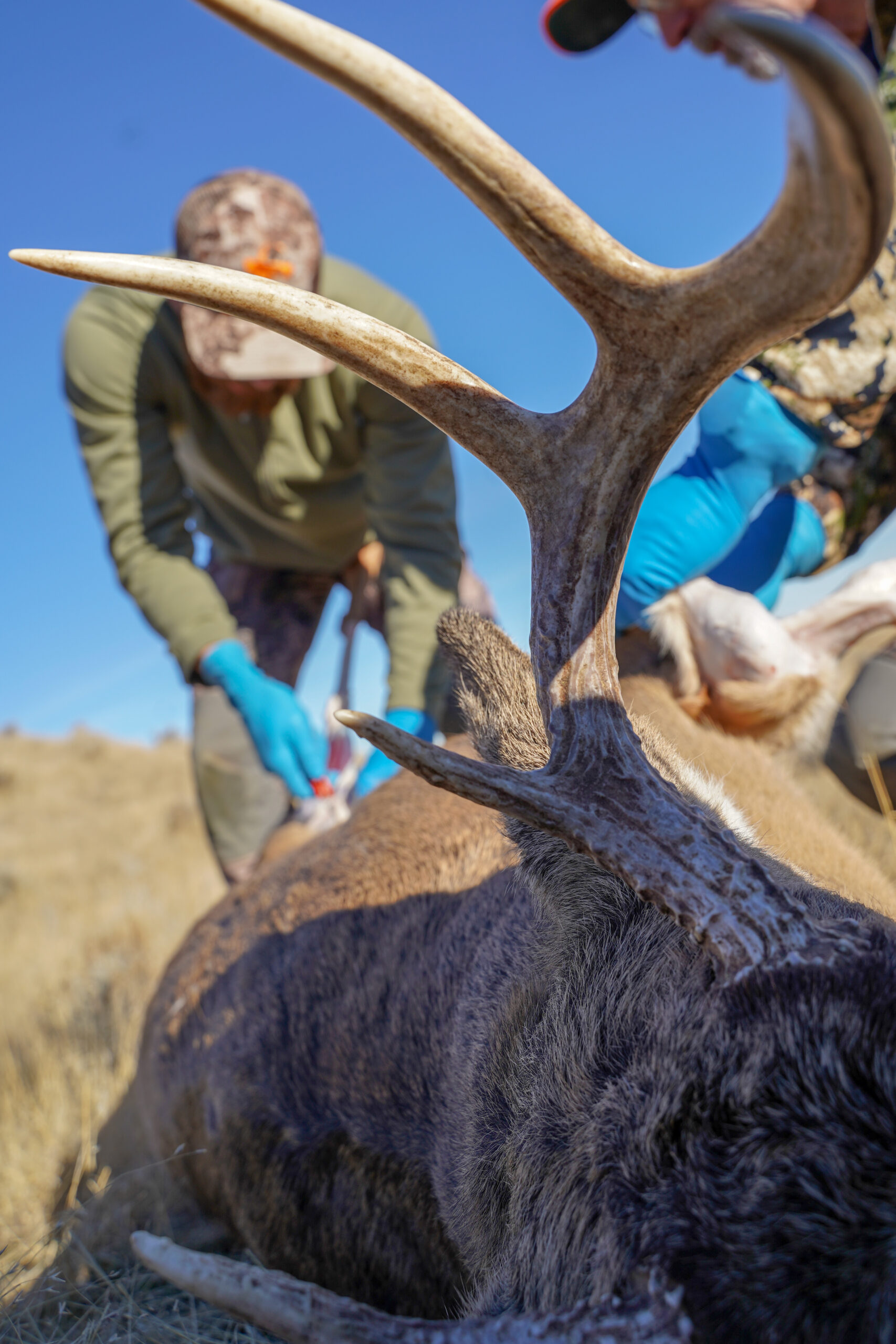Home » News » Field to Table: Field Dressing 1-0-No!
Field to Table: Field Dressing 1-0-No!

Christopher Kyer (The Honest Omnivore) is a modern day renaissance…
Field dressing a deer when things go sideways.
The first deer I ever saw field dressed was a young blacktail doe in Washington. My friend Harry had made a shot that many would envy. From less than twenty-five yards away, he put a .308 bullet in her neck right at the base of the skull. She dropped like a stone and never felt a thing. We’ll leave the ethics of shot placement for another time. Needless to say, a shot like that makes field dressing feel more like surgery. No blood fills the chest cavity. There is no burst stomach or intestines, no bone fragments or hemorrhaged tissue.
One hundred things can go wrong.
I have field dressed other deer and pronghorn after similar neck and head shots. Most, however, have been shot in the chest and killed with certainty out to four hundred yards. Field dressing a deer shot like this is hopefully the most common scenario for you. But a hundred things could go wrong. The deer could take a step at the last second, or you flinch, or the arrow hits a twig—whatever it is, you end up with a deer shot in the liver, stomach, or intestines.
While it’s not ideal, it also doesn’t have to be an insurmountable obstacle in the quest for quality protein. Even if nothing went wrong with the shot, there’s always the chance you’ll mess up later. Maybe a slip of the knife opens the paunch or the bowel tears off while you’re trying to pull it through the pelvic tunnel. None of this is perfect, but none of it is the end, either.
A mess does not have to be spell the end.
Deer are ruminates. This means they are in a large class of mammals who possess a multi-chambered stomach designed to digest vegetation through a fermentation process. The rumen, or paunch, is the largest of the four “stomachs” and the part you will see when you open the body below the breastbone. If you nick this while opening the deer, you’ll get a shot of warm, pungent gas. It’s not as bad as it sounds. If you’ve ever been on a brewery or distillery tour, you’ll recognize the smell of fermenting vegetation instantly.
A little gas and green glop is one thing. A paunch blown wide open by a high velocity bullet is another. When you open a deer that has been hit in the paunch, the mess of blood and stomach contents will be everywhere. It will make field dressing a sloppy experience. I recommend gloves. Otherwise, you can proceed as usual. The main connective points are still there: diaphragm, trachea, esophagus, bowel.
If the hit was further back, the projectile may open up the small intestine or upper large intestine. Or it may not. These organs are tough, slippery, and mobile within the body cavity. They are harder to rupture or cut than you might think. But if you do, you will encounter some unpleasant odors. You might not gag, but no one will say it smells fine. Gloves are great for keeping the odors off your hands and making it more tolerable to handle the grosser fluids.
Whatever you do, don’t panic.
Sometimes when I am pulling the bowel back through the pelvic tunnel, it tears. Yes, it rips right in two. It may result in pellets of feces dropping into the body cavity. This happens when I haven’t cut the bowel sufficiently from the anus side. Don’t panic. Carry on with getting the bowel and vagina removed. Work from both sides of the pelvic tunnel if you have to. Whether it’s a lot of feces or just a few pellets, it should all go with the rest of the guts when you dump them out.
Once you’ve gotten the deer gutted, drain the blood. After a minute, flip the deer back over and use rags, paper towels, or a gloved hand to remove as much contaminates from the cavity as possible. If you have access to large quantities of clean water, rinse the cavity thoroughly and flip the deer to drain.
Be careful when using water.
Water is a tricky thing when it comes to field dressing and meat care. Keeping things dry is generally a better choice. Bacteria thrive in wet, warm conditions and bacteria is certainly a contaminate than can ruin venison. Yet water can and should be used to remove contaminates that already exist. The key is to make sure that water doesn’t remain for any length of time anywhere in the body cavity. This is especially true in warmer conditions. After rinsing, wipe the cavity and any exposed tissues dry. We’ll talk more about water and the dual role it plays later on.
One important thing to learn is that with the sole exception of the tenderloins, all of the meat on a deer is separated from the innards, and now the contaminates of the outside world, by layers of fascia, bone, and membrane. Since I don’t split the breastbone or pelvis, only the barest minimum of meat is exposed. This will become especially critical when moving your deer out of the field and into your vehicle.
It wasn’t pretty, but you’re done.
Deer shot in the gut are never desirable. A poor short means you have a mess to deal with. But in and of itself, a gut shot is not a barrier to achieving high-quality venison. The other possibility of a gut shot deer is that you don’t recover it as quickly as you should. A deer that isn’t recovered in time can begin to decompose. That window of time can be brutally short in warmer weather.
Next time, we will review one of the most important aspects of harvesting the best venison: cooling down the carcass to prepare for butchering.
Christopher Kyer (The Honest Omnivore) is a modern day renaissance man -- hunter, fisherman, writer, maker, philosopher, and foodie! Born in West Virginia and educated in New Jersey and Michigan, Chris has spent his adult life split between the Pacific NW and the Chicago suburbs. He started cooking with his grandmothers and hunting with his PawPaw before he was 10 years old, and the woods and a kitchen are still where he feels most at ease.



